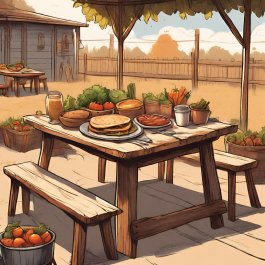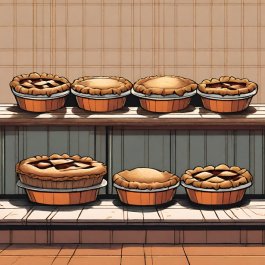Read by Michael Flamel

Once upon a time, in a quaint little town called Harmonyville, there was a farmer named Old John. He’d been tilling the same soil for decades, growing everything from corn to kale, but he always did it with a smile on his sun-weathered face. You see, Old John was a man ahead of his time, a visionary farmer who believed in the magic of farm-to-table living long before it became trendy.
It all began when Old John’s granddaughter, Molly, returned from the big city after completing her culinary degree. She had seen the rise of farm-to-table dining in the bustling metropolis and couldn’t wait to bring a slice of that life back to Harmonyville. Armed with knowledge, a passion for cooking, and an infectious enthusiasm, Molly set out to transform the town’s dining scene.
Her first venture was “Molly’s Garden Kitchen,” a tiny restaurant nestled between the cornfields and the pumpkin patch. She sourced her ingredients exclusively from her grandpa’s farm and the neighboring farms, creating a menu that changed with the seasons. Molly’s dishes were nothing short of magical—fresh, vibrant, and filled with the essence of the earth itself.

Word spread quickly in Harmonyville. Soon, the townsfolk were flocking to Molly’s Garden Kitchen, lining up for a taste of farm-to-table goodness. They marveled at the flavors and textures that seemed to burst forth from each plate, like the countryside had conspired with Molly to create a symphony of taste.
But Molly’s success wasn’t just about the food; it was about the experience. She’d set up long wooden tables, lit with twinkling fairy lights, in the middle of her garden. Diners could pluck their own herbs and garnishes, pet the farm’s resident goats, and sip homemade cider from mason jars. It was a dining experience like no other, and Harmonyville couldn’t get enough.
Soon, other chefs in town started to follow Molly’s lead. The local butcher began to source his meats from nearby ranches, and the baker started using grains from local mills. Even the dairy farmer, whose cows had been producing milk for generations, began crafting artisanal cheeses.
As farm-to-table dining spread like wildfire through Harmonyville, it ignited a passion for all things agrarian. People started planting their own gardens, attending farmers’ markets, and joining community-supported agriculture programs. The town’s bookstore had a sudden spike in sales of gardening and cooking books, and local hardware stores couldn’t keep up with the demand for shovels, rakes, and watering cans.
The Mayor of Harmonyville, Mayor Jones, couldn’t believe his luck. He’d been trying to boost tourism for years, and now people were coming from far and wide to savor the flavors of his little town. He even started hosting “Harmonyville Harvest Fest,” a yearly celebration of all things farm-to-table. The event featured cooking competitions, hayrides, and even a “Best Pie Made from Scratch” contest. It became the talk of the state.

One day, Mayor Jones was sitting on his porch, sipping on a glass of Molly’s famous homemade cider, when he said to his wife, “You know, I think I’ve figured it out. The secret to happiness isn’t in the city lights or the fast pace of life; it’s right here in our own backyard.”
His wife nodded in agreement, and they clinked their glasses together in a toast to the simple joys of life in Harmonyville.
And so, Harmonyville embraced its farm-to-table renaissance with open arms and full stomachs. Old John, looking at his granddaughter with pride, knew that Molly had sparked a delicious revolution in their little town. It was a lesson for everyone: connecting with your food brings joy to the table, and there’s nothing quite like the taste of homegrown happiness. ❖


 Previous
Previous

